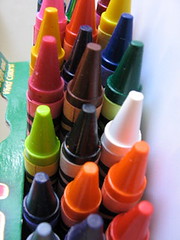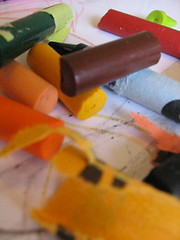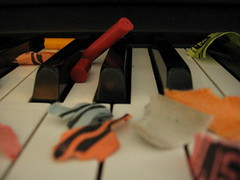
My second year in college I lived down the hall from a woman whose
grandfather invented
Jiminy Cricket. The fact that she was related to an original Disney animator only meant that she had some good stories to tell; she was otherwise fairly humble and modest about her family ties. Late at night, hers was the perfect room to stop by for spirit-reviving conversations (I'd always been too long cloistered in a practice room). The meandering chats sometimes kept us up until four in the morning, but they were oddly addictive, as profound as they were silly.
One time, she told a story about Ward teaching a beginning drawing class. The students--adults with the eager-to-please attitude of elementary schoolkids--arrived with their art supplies: proper paper, drawing pencils, paintbrushes, a box of pastel crayons. He began the very first class by asking the students to
take the crayons from the box and
break them. Unwrap them.
Snap them in half. In thirds. Most students resisted the request; after all, who doesn't love a perfect, brand new crayon? Who wants to destroy their newly purchased supplies?

Kimball offered an explanation only after getting the students to perform some carnage on their precious instruments. He demonstrated how the broken crayons could yield all kinds of different shadings, textures, and widths of color. Simply picking up a new crayon and holding it "right" side up, with the narrow (or stubby--yes, I do realize that Kimball's "crayons" were likely
not from the Crayola box) point poised over the paper, limited the tempo and the articulations of
the act of drawing. And if the practice of drawing is thus inhibited, what could one hope to produce? How could one explore a range of dynamics? It is absolutely true, and yet, how many people think outside the box, tear the labels off their crayons, break them in half, roll them sideways or scratch the finest edge across the paper? Too often, we probably just pick it up like a basic pencil and draw as if we were penning someone a letter. We limit our creative visions because our idea of
how to use the tool is limited.
I often sit
at the piano and wonder how to break crayons. What am I doing out of lazy habit? Am I limiting myself? Ok, how? When am I just mindlessly pulling a new crayon from the box and putting its tip to paper? What do I do because I feel it is technically the "right way," the way I've been schooled and trained, and
what way, however unorthodox, might actually lead to some stellar bit of piano playing, to a decidedly original

interpretation? I often think of this story, of breaking crayons, and I feel myself right there on day one in a Disney animator's class. I may not have many answers on breaking crayons at the piano, but I "get" the concept, and it certainly keeps me at play.
continue reading...
 My second year in college I lived down the hall from a woman whose
My second year in college I lived down the hall from a woman whose  Kimball offered an explanation only after getting the students to perform some carnage on their precious instruments. He demonstrated how the broken crayons could yield all kinds of different shadings, textures, and widths of color. Simply picking up a new crayon and holding it "right" side up, with the narrow (or stubby--yes, I do realize that Kimball's "crayons" were likely
Kimball offered an explanation only after getting the students to perform some carnage on their precious instruments. He demonstrated how the broken crayons could yield all kinds of different shadings, textures, and widths of color. Simply picking up a new crayon and holding it "right" side up, with the narrow (or stubby--yes, I do realize that Kimball's "crayons" were likely  interpretation? I often think of this story, of breaking crayons, and I feel myself right there on day one in a Disney animator's class. I may not have many answers on breaking crayons at the piano, but I "get" the concept, and it certainly keeps me at play.
interpretation? I often think of this story, of breaking crayons, and I feel myself right there on day one in a Disney animator's class. I may not have many answers on breaking crayons at the piano, but I "get" the concept, and it certainly keeps me at play.


